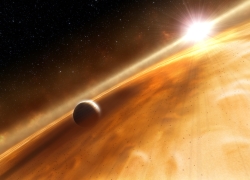Extra-Solar Planets

Summary
Since 1992, over 3500 planets have been discovered outside of our own Solar system. We start this module by looking back to the early days of planet hunting, and we explore the various techniques that are used to discover new worlds. A demonstration and practical activity will allow participants to recreate the detection method known as transit hunting, where astronomers look for tiny drops in light as a planet passes in front of its host star. We then look at how planetary systems form, and how orbital interactions can lead to the existence of highly unusual and unexpected planets. By investigating how observers can study the atmospheres of exoplanets, we look at how future technology will allow us to look for signs of life on these distant worlds. Students finish with a practical activity to investigate the habitable zone around different types of stars.
Age Range
11 – 16
Duration
45 minutes
Module Composition
- Introduction to Exoplanets – Presentation
- Hunting for Transits – Practical Activity
- Planetary Formation – Presentation
- Could life exist on other worlds – Presentation
- Habitable Zone – Practical Activity
Extension Activities
- Extra-Solar Planet Encyclopedia – everything we know about exoplanets.
- Exoplanet Physics – exoplanet resources on the IOP website.
- Exoplanet Transit Simulator – see how planet size affects the transit light-curve of an exoplanet.

Follow Us: